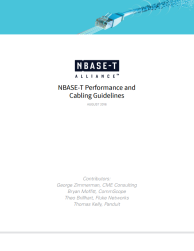How to Evaluate Your Cable Plant as per NBASE-T Standards
September 1, 2016 / General, Standard and Certification, Industrial Networks
If you’re looking to deploy 802.11ac on existing cabling, you have probably been watching developments in the NBASE-T world. NBASE-T is the technology that promises to provide speeds up to 5 Gbps to support the fastest 802.11ac access points over existing Cat 5e or 6 cabling. The NBASE-T PHY-layer specification is compatible with the draft version of the IEEE P802.3bz standard, which defines the technical baselines for 2.5G and 5GBASE-T Ethernet. The standard is expected to be ratified in September 2016.
However, not every version of NBASE-T will operate on every cable, so Fluke Networks worked with industry leaders at CommScope and Panduit to provide guidelines for evaluating the readiness of existing cabling installations for NBASE-T deployment. This paper provides critical guidance so owners know what to expect and contractors can provide accurate advice to prevent any cable-related problems in deployment.
The short version of the story: Network owners should consult with their cable installation contractor to assure that their cabling plant is ready for NBASE-T. Reviewing existing certification documentation may confirm you’re ready. If not, strategies such as minimizing bundles or enabling downshift features will help ensure reliable network performance. And while NBASE-T systems can compensate for various types of crosstalk and will work at specified speeds in most networks with existing cabling, re-evaluation of the cabling infrastructure may be suggested where long bundles of Cat5e or Cat6 cables exist.




